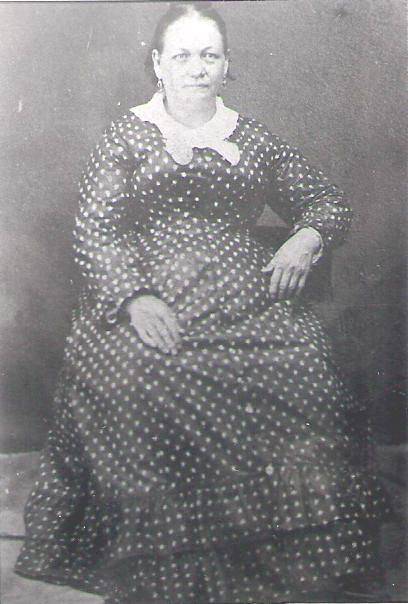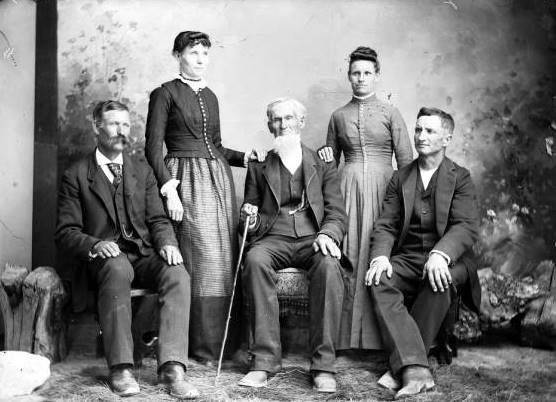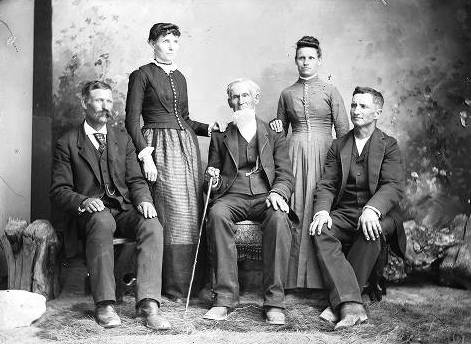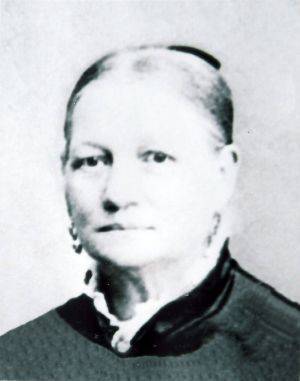HISTORY OF HENRY PACKARD (Almira’s Third Husband)
By Dennis Kroll, Southern California (2008)
“Almira Mehitable Meacham… “went through all kinds of hardships endured by the early day converts of the Mormon Church. The family in their westward migration had made a temporary stop at Springfield, Illinois, where Almirira, at the early age of fifteen, was married to Andrew Palmer. To this marriage were born two sons, Almon Babbitt, who came to Utah and settled at Nephi, and Warren, who died in infancy. Soon after the death of this son, the father died. Two years later, Almira was married in the Nauvoo temple to Edwin Whiting as a plural wife. To this marriage were born the following children, most of them in Sanpete and Utah Counties, Utah: Edward Lucian, Cornelia, Ellen Emerett, Katherine Emeline, Edwin, Frank, and Sylvia Almira.
The Whitings had come to Utah with Captain Morley’s company in 1849 and settled in Manti where Mr. Whiting became quite prominent. In “Pioneers and Prominent Men of Utah” he is listed as the first mayor of Manti and as having held other important positions of public responsibility.
In 1861 the family moved to Springville where they lived during during the early Indian troubles known as the Black Hawk and Walker Indian Wars.
Almira became one of Utah County’s early nurses and midwife and did much in that way to provide a living for her family.
Plural marriage did not bring happiness and in 1861 Almira and Whiting separated. July 24, 1863, Almira married Henry Packard and to this, her third marriage, was born a daughter, Sophia Olive Packard. Later the Packards moved to Healdsburg, California, where they lived until 1896 when Mr. Packard died.
After the death of her husband, Almira moved to San Bernardino where she lived in a home given her by her son-in-law, Nathan Henry Barton, and her daughter Sylvia. She passed away in 1898 and is laid to rest in the Pioneer Cemetery in San Bernardino, California.”
Henry Packard
Birth: May 6, 1825 Parkman Geauga County Ohio, USA
Death: Nov. 17, 1896 Healdsburg Sonoma County California, USA
Son of Noah Packard & Sophia Bundy
Living his youth in a place called Nauvoo, Illinois, the saints had built a city which at the time was bigger than the city of Chicago. They had also built a temple which was the largest and most expensive building west of Philadelphia. From here they were driven by their enemies to a resting place called Council Bluffs, Iowa. Here, Henry enlisted in the Mormon Battalion, an army of 500 men called to fight in the war with Mexico and help secure California for the U.S. as part of Manifest Destiny. It was and still is, the longest infantry march in U.S. Military history. There is hardly an event that occurred in the American west between 1846 to 1848 that some of the members of this group did not take part in. Henry was probably the second Packard in California.
Henry Packard was born May 6, 1825, in Parkman, Geauga, Ohio, the third child of Noah Packard and Sophia Bundy. His parents were some of the early settlers in that town, and when he was seven his family were converts to the Mormon Church.
In 1840 the family moved to Nauvoo, Hancock, Illinois, which one year before was nothing more that a marshy bend in the Mississippi River called Commerce, which contained a few log cabins. Their new home being located across the street from the city’s founder, mayor and spiritual leader, Joseph Smith. Passers-by were amazed at what the saints had built in such a short time, which shocked their enemies as well. A year and a half after the murder of Joseph Smith, they were driven from the state as both the federal and state governments stood idly by and watched it happen.
Henry’s father was too ill and too poor to leave Nauvoo that February of 1846 and cross the frozen Mississippi River with Brigham Young, but he at least sent his three oldest sons to help the saints move to their new home in the West. They traveled as far west as Winter Quarters, Nebraska.
At Mt. Pisgah (Grand River), Iowa, the saints were met by Captain James Allen, under the command of Colonel Stephen W. Kearny, commander of the U.S. Army of the West stationed at Fort Leavenworth, Kansas. He brought orders authorizing him to enlist 500 volunteers for a year, in a campaign to secure California in the war with Mexico. On July 20, 1846, the battalion started their march from Council Bluffs, Iowa, to Fort Leavenworth. At this time Captain Allen was promoted to Colonel and Kearny was promoted to General.
When the battalion reached Fort Leavenworth August 1st, there were 22 officers and 474 enlisted men for a total of 496. There were also 34 women and a number of children. 20 of the women were assigned as laundresses, four to each company. All of the clothing pay allowance was sent back to the church and the families of the men in Council Bluffs to help them cross the plains to the valley of the Salt Lake. The men were each issued a musket, bayonet, scabbard, cartridge box and leather belt. A white belt was the only clothing which they all had in common. They were also each issued a blanket, canteen & knapsack, and each mess group of six was issued cooking pots and a tent. Each of the five companies was allowed to buy a wagon with a four mule team, in which they could carry their gear.
On August 13th they started with orders to go to Bent’s Fort, Colorado. Colonel Allen was too sick to lead the men and stayed at the fort. Capt. Hunt would be in command until Col. Allen could rejoin the group. On August 26th at Bluff Creek, Kansas, word reached the battalion of Col. Allens death. On the 29th, Lieutenant Andrew Smith and Dr. George Sanderson arrived from the fort to take command of the battalion, with orders to go directly to Santa Fe now that it had been captured by Kearny’s advance party. Most of the men wanted Capt. Hunt to continue the command since he out ranked Lt. Smith, but the officers voted to give the command to Lt. Smith since he was a career soilder and West Point graduate. However, Lt. Smith did not like volunteers, let alone Mormon volunteers. Also, because the battalion’s re-supplies had been sent ahead to Bent’s Fort and they were now ordered to go to Santa Fe, the men were put on half rations.
Just after they left the Arkansas River a sick detachment was sent to Pueblo, Colorado, via Bent’s Fort. Many of the men were sick from exposure to the elements and Dr. Sanderson (Dr. Death) prescribed a dose of calomel powder and arsenic, no matter what was wrong with them. The men marched sick, under fed and under clothed, from water hole to water hole all the way to Santa Fe, arriving October 12, 1846.
At Santa Fe they were given a new commander, Colonel Philip St. George Cooke, who had been with Kearny’s advance party, but was sent back to take command after Kearny learned of Allens death. Col. Cooke told the men that they had orders to make a new wagon road to the Pacific along a southern route, something that had never been done. From here another sick detachment left for Pueblo with all of the remaining women except five and all of the remaining children except one boy.
On October 18th, they left Santa Fe with 25 government wagons and 60 days rations, 5 company wagons and 12 private family wagons. Upon learning that Gen. Kearny had abandoned his wagons, Col. Cooke also brought along pack saddles for the mules. He also ordered that the men be organized into messes of ten men each. On the 24th they arrived at Albuquerque and exchanged some mules. From here they traveled south down the western side of the Rio Grande River. Just before they left the river they sent another sick detachment back to Pueblo, leaving 335 men in the battalion. On Nov. 13th they left the Rio Grande and began blazing a new wagon trail. Rations to the men were again reduced.
From here the men blazed a new road through the southwestern part of New Mexico into Mexico and up into Arizona along the San Pedro River Valley. On December 11th as they were watering the animals, some wild bulls got in with the cattle and were killed by the sheep drovers. Later that day another group of wild bulls charged the men and a short but wild melee ensued. The rampaging bulls charged on and on as they attacked men, mules and wagons. Three men were wounded, three mules were gored to death and several wagons were tipped over. Corporal Frost was charged by a bull from one hundred yards, took aim and fired when it was ten paces from him and it dropped at his feet. Col. Cooke later said of the man, “One of the bravest men he ever saw.” It is not known how many bulls were killed in all, but one person reported nine dead in one spot. Many reported over 20 dead in all and maybe three times that many wounded.
Just before they arrived at Tucson, the garrison of Mexican soldiers stationed there had fled to the south on hearing of their coming. After a short stay they marched north to the Gila River and the Pima Indian villages. From here they basically followed the southern edge of the Gila River to the Yuma crossing of the Colorado. From there to Mexicali, then north to Palm Springs, following the San Luis River through the Temecula Valley arriving at San Luis Rey January 27, 1847. Much of this route later became known as the Spanish Trail, San Antonio-San Diego Route and the Butterfield Stage Line.
On July 31, 1846, a large group of Mormons arrived at El Paraje de Yerba Buena (The Place of the Good Herb), later called San Francisco, aboard the ship Brooklyn, under the leadership of Samuel Brannan. This was a month after the Bear Revolt had taken place and soon after Commander Montgomery aboard the USS Portsmouth had taken control of the area for the US without a shot being fired. The local Mexican General at the Presidio and many of the local residents of the bay area having fled to the south.
Upon reaching California the battalion learned that it had already been secured from Mexico by Fremont and Kearny, but all was not peaceful. John C. Fremont had been installed Governor of the state by Commodore Stockton. Lt. Col. Fremont along with Commodore Stockton were refusing to take orders from Gen. Kearny, who had been given orders by President Polk to be the Governor of California after it was secured. With the arrival of the battalion loyal to Kearny, he then had more than enough men to enforce his authority. From here the battalion was split with one company going to San Diego and four companies, along with Henry, going to Pueblo de Los Angeles, where they built Fort Moore. At some point during the trip Henry was promoted from Private to Corporal.
On May 31, 1847, 15 members of the battalion along with Gen. Kearny and other officers left Monterey with Lt. Col. John C. Fremont, taking him back to Fort Leavenworth for court-martial. This group was the first to discover the remains of the Donner Party at Truckee Lake, other than the original rescue parties. It was a gruesome sight of dismembered bones and body parts!
When the battalion was discharged July 16, 1847, at Fort Moore, the government tried to get as many men as possible to re-enlist for another six months. Henry was one of 79 who did, and they spent their time stationed at San Diego. There he was promoted to Sergeant. About 118 of the men headed east to Lake Arrowhead and then later northeast to the valley of the Salt Lake. About 105 other men traveled north to the Coloma area and worked for Captain John A. Sutter at his fort and mill, where gold was discovered January 24, 1848. Six of these men became The California Star Express riders, carrying printed word of the gold discovery back to the east, starting the California gold rush.
After the volunteers were released in San Diego on March 14, 1848, half went northeast to Utah and the other half, as well as Henry, traveled north to Yerba Buena and the gold fields.
Many of these men left in 1848 and headed back east to Utah. It is not known exactly when Henry left, but we know that he was in Salt Lake City when his parents arrived there September 17, 1850.
About 26 members of the battalion died during the the trip and never made it back to their families, though not a single shot was fired in battle, except during the battle with the bulls. The battalion proved the worth of this area which was later to become the Gadsden Purchase. They pioneered the southern emigration route, as well as the Carson Pass route through the Sierra Nevada’s.
While living for a short time in Salt Lake City and building a mill race for Archibald Gardner with his father and brothers, Henry met and married Mary Mariah Chase January 16, 1851. She was the younger sister of one of his fellow battalion soldiers.
Henry and his new bride then moved to Hobble Creek with the rest of his family. I do not know what happened to this marriage, or if there were any children from it.
On July 24, 1863, Henry married Almira Mehitabel Meacham, who had eight children from two previous marriages. At some time, probably during the late 1860’s, he moved back to northern California with his family and lived in Healdsburg, Sonoma, California, where he died November 17, 1896, leaving no known children that I know of, other than his second wife’s.”
Sources: Burial:: Oak Mound Cemetery <http://www.findagrave.com/cgi-bin/fg.cgi?page=cr&GRid=29262587&CRid=8216&>
Healdsburg
Sonoma County
California, USA
Created by: Todd Schott <http://www.findagrave.com/cgi-bin/fg.cgi?page=mr&GRid=29262587&MRid=46932087&>
Record added: Aug 23 2008
Find A Grave Memorial# 29262587







